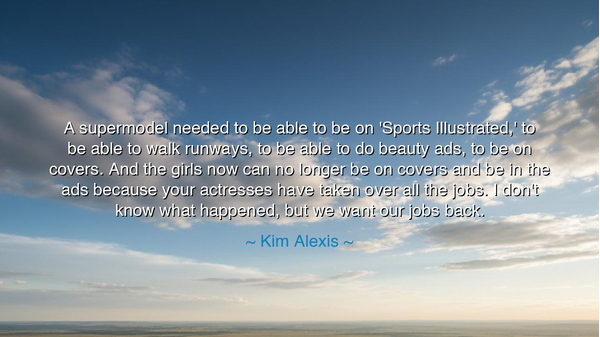
A supermodel needed to be able to be on 'Sports Illustrated,' to
A supermodel needed to be able to be on 'Sports Illustrated,' to be able to walk runways, to be able to do beauty ads, to be on covers. And the girls now can no longer be on covers and be in the ads because your actresses have taken over all the jobs. I don't know what happened, but we want our jobs back.






In the ever-changing world of beauty and fashion, where the pursuit of perfection is ceaseless, there comes a time when one must pause and reflect on the shifting tides. Kim Alexis, a woman whose name became synonymous with the golden age of supermodels, speaks with a sense of longing and frustration when she says, "A supermodel needed to be able to be on 'Sports Illustrated,' to be able to walk runways, to be able to do beauty ads, to be on covers. And the girls now can no longer be on covers and be in the ads because your actresses have taken over all the jobs. I don't know what happened, but we want our jobs back." These words carry not just the frustration of one individual, but the quiet reverence for an era that has passed, a reminder of a time when the supermodel ruled, and the world of fashion and beauty seemed to have a clear and distinct order.
The world of fashion, like the world of ancient empires, has its own rules and hierarchies. In the ancient civilizations, such as Egypt and Greece, beauty was often celebrated, but it was reserved for the highest echelons of society. Royalty and gods were depicted as idealized versions of beauty, and the pursuit of beauty was both a reflection of status and a tool of power. The great statues of Venus de Milo and the goddesses of ancient Greece served as symbols of an ideal, a standard of beauty that the people could aspire to but could never fully attain. In the same way, Alexis' reflection on the changing landscape of beauty in the modern age speaks to a shift in who holds the power to define that standard.
In Alexis’ time, the supermodel was not just a model; she was a symbol of an era, a beacon of beauty that was uniquely hers. The supermodel, with her towering height, striking features, and commanding presence, stood as the centerpiece of an industry. Her image graced the covers of magazines, the billboards in every city, and the pages of fashion spreads, setting the standard for a generation. But just as the ancient gods and goddesses of beauty gave way to mortal heroes, so too did the supermodel's reign diminish as the world of beauty shifted. Actresses, with their star power and versatility, began to take center stage, capturing the attention and admiration of the world, eclipsing the supermodel's place in the sun.
Consider the story of Helen of Troy, whose beauty was said to be so great that it sparked a war—the Trojan War itself. Her beauty was more than just physical; it was a symbol of the power and influence beauty could wield in the ancient world. Yet, even Helen’s beauty was not enough to avoid the shifting tides of fate. What was once a singular symbol of power and influence began to fade, just as the supermodel's role began to be overshadowed by the multi-faceted star power of actresses. Helen's story reminds us that beauty, while powerful, is also fleeting, and the idols of one age can be replaced by the idols of another.
What Alexis’ words speak to, then, is not just a loss of jobs, but the loss of an era, a time when the supermodel was a symbol of a certain kind of beauty—one that was pure, one-dimensional, and clearly defined. Now, beauty is no longer confined to one realm or one category. Actresses, with their ability to shift between characters, to convey depth and complexity, have transcended the traditional boundaries that once defined beauty. They have become the new archetype—the modern Helen of Troy, not just admired for their looks, but for their versatility, their personalities, and their ability to embody multiple facets of human experience. The shifting of the supermodel’s role is a reflection of a greater shift in the way we view beauty itself.
The lesson here, then, is a reflection on the impermanence of beauty, fame, and the standards that society creates. Just as the gods and goddesses of ancient Greece were replaced by mortal heroes, so too are the symbols of beauty in our own time subject to change. Beauty, like power, is transient, and those who hold it must be aware that the tides will inevitably shift. The true measure of greatness is not found in a fleeting moment of fame, but in the ability to adapt, to evolve, and to find new ways to contribute to the world.
So, let us take this lesson to heart: do not become too attached to the fleeting symbols of beauty or power. Like the great empires of old, beauty is built upon the ever-shifting sands of time. We must find within ourselves the ability to embrace change, to redefine ourselves as the world shifts around us. Like the supermodels who ruled an era but must now find new ways to thrive, we too must recognize that our worth is not defined by the fleeting standards of beauty or success, but by our ability to evolve and find our place in the ever-changing world. In doing so, we can create legacies that are not bound by the whims of fashion, but by the true, enduring strength of our spirit.






AAdministratorAdministrator
Welcome, honored guests. Please leave a comment, we will respond soon